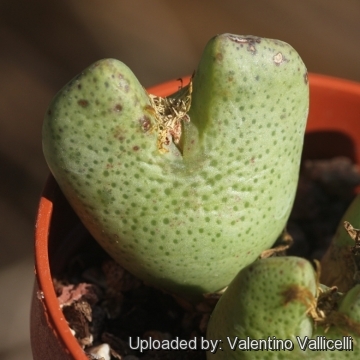
Conophytum quaesitum subs. densipunctum Photo by: Valentino Vallicelli
Origin and Habitat: Southern Namibia.
habitat: Conophytum quaesitumSN|25116]]SN|25116]] subsp. densipunctum is known from between 4 and 10 sub-populations and locations. It grows on steep, lower to upper southeast-facing mountain and hill slopes, in quartzite crevices in the shade often along with Lithops karasmontanaSN|12138]]SN|12138]]. Collecting may be a potential threat.
Synonyms:
See all synonyms of Conophytum quaesitum
Description: Conophytum quaesitumSN|1166]]SN|25116]] subsp. densipunctum (L. Bolus) S.A.Hammer is the the northerly populations of C. quaesitum in Namibia distinguished by more robust nature with a pale yellowish green, always densely spotted epidermis and by its even keel (that of Conophytum quaesitumSN|25116]]SN|25116]] is often notched or sinuate). The bodies are the largest of any taxa in the Saxetana section and out of flower could be mistaken for Conophytum bilobumSN|25116]]SN|1166]]. However it has the small nocturnal flowers typical of this section.
Habit: It is a dwarf compact ground-cover succulent with bi-lobed light green bodies. It is not sunken, heavily branched and grows in tight mats or large cushions.
Stem: Stemless or with very short stems with time.
Bodies (paired leaves): 15-35 x 12-20 x 10-14 mm, thick unless spindled by poor light, obovate, laterally compressed, bilobed at the apex. The leaf-tips (lobes) incompletely fused, diverging or appressed, triangular in shape and keeled. Fissure rhombic, impressed, papillate. The epidermis is pale-green or yellowish-green and heavily spotted and sometimes (The vars. quaesitum and rostratum are often spotless). Keels sharp, sometimes glossy, irregularly bowed, ragged often yellowish, pinkish or carmine. During the summer season, plants aestivate and the body is gradually replaced by a new young pair of leaves. Sheath white, heavily spotted with tannins, persistent.
Flowers: Small, creamy- white, intensely scented and thus attracting night-flying insects especially moth (phalaenophilous).
Blooming season: The flowers are autumnal. Flowers initially nocturnal, later remaining open in day.
Fruit: Hygrochastic seed capsules 4-7-locular, that usually remain on the plant, but strong winds can dislodge and blow them over considerable distances.
Bibliography: Major references and further lectures
1) James Cullen, Sabina G. Knees, H. Suzanne Cubey “The European Garden Flora Flowering Plants: A Manual for the Identification of Plants Cultivated in Europe, Both Out-of-Doors” Cambridge University Press, 11/Aug./2011
2) Raimondo, D., von Staden, L., Foden, W., Victor, J.E., Helme, N.A., Turner, R.C., Kamundi, D.A. and Manyama, P.A. 2009. “Red List of South African Plants.” Strelitzia 25. South African National Biodiversity Institute, Pretoria.
3) Hammer, S. 1993. “The Genus Conophytum - A Conograph.” Succulent Plant Publications, Pretoria.
4) Hammer, S. 2002. “Dumpling and His Wife: New Views of the Genus Conophytum.” East Anglia Engraving Creative Colour Ltd, Norwich, England.
5) Matlamela, P.F. & Kamundi, D.A. 2006. Conophytum quaesitum (N.E.Br.) N.E.Br. subsp. quaesitum var. quaesitum. National Assessment: "Red List of South African Plants" version 2013.1. Accessed on 2014/01/28
6) Loots S. "Red Data Book of Namibian plants." Southern African Botanical Diversity Network Report No. 38. SABONET, Pretoria and Windhoek. 2005
 Conophytum quaesitum subs. densipunctum Photo by: Valentino Vallicelli
Conophytum quaesitum subs. densipunctum Photo by: Valentino VallicelliSend a photo of this plant.The gallery now contains thousands of pictures, however it is possible to do even more. We are, of course, seeking photos of species not yet shown in the gallery but not only that, we are also looking for better pictures than those already present.
Read More... Cultivation and Propagation: Conophytum quaesitumSN|25116]]SN|25116]] is a "winter" grower which is most active from late winter until later spring and heading for summer dormancy, but in favourable growing conditions it keeps going over the summer too and doesn't need particular care. All the forms of Conophytum quaesitumSN|25116]]SN|25116]] are easy to grow.
Soil: Requires good drainage as it it is prone to root rot. It can grows outdoor in sunny, dry, rock crevices (protection against winter wet is required) It can also be cultivated in alpine house, in poor, drained soil.
Watering: It requires little water; otherwise its epidermis breaks (resulting in unsightly scars). Water minimally in summer, (only when the plant starts shrivelling), but it will generally grow even in summer if given water. Water regularly in winter after the previous year's leaves have dried up. Requires good drainage.
Fertilization: Feed it once during the growing season with a fertilizer specifically formulated for cactus succulents (poor in nitrogen), including all micro nutrients and trace elements diluted to ½ the strength recommended on the label. It thrives in poor soils and need a limited supplies of fertilizer to avoid the plants developing excess vegetation, which is easily attacked by fungal diseases.
Exposure: Keep cool and shaded in summer, it needs full sun or light shade.
Temperature: Hardy to -2°C. Ensure a very good ventilation.
Repotting: Avoid to repot frequently. This plant may stay in the same pot for many years.
Uses: Container, rock garden.
Pests and diseases: It is vulnerable to mealybugs and rarely scale.
Propagation: It can be reproduced both by cuttings and seeds. Take the cutting from a grown-up mother plant. Each cutting must contain one or more heads along with a fraction of root. It is easily propagated by seed. The small seeds can be sown in pots of fine, well-drained sand, any time during the spring and summer months when temperatures are warm. Cover the seeds with a very fine layer of grit and water from below with a fungicide to prevent damping off. For the first 3-4 days cover the pots with a sheet of glass/clear perspex to keep the humidity levels high. Remove the glass and replace it with light shadecloth and mist once or twice a day for the next two weeks after which most seeds should have germinated. From then on mistings can be reduced to every second and then every third day as the little plants grow.











